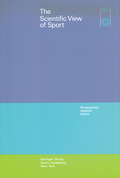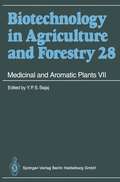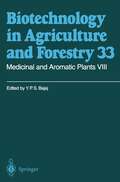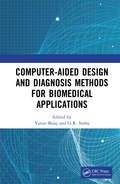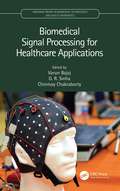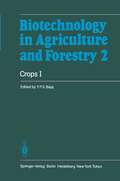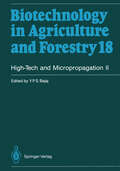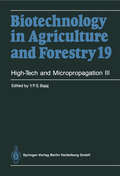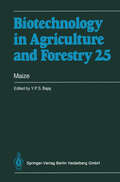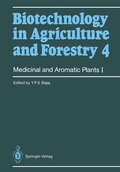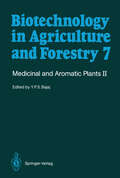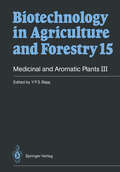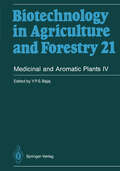- Table View
- List View
Die Gleichungen der Physik: Meilensteine des Wissens
by Sander BaisSeit Jahrtausenden versuchen wir, die Natur zu verstehen. Wir konnten einige der grossen Mysterien enträtseln, die uns umgeben, indem wir den Makro- und Mikrokosmos mit immer raffinierteren Werkzeugen untersuchen. Nicht nur, dass wir dabei eine überwältigende Vielfalt an Fakten gesammelt haben, wir enthüllten sogar Grundgesetze, welche die Struktur und Entwicklung der physikalischen Realität steuern. Insbesondere lernten wir aus diesen Beobachtungen, dass die Natur sich uns in der Sprache der Mathematik mitteilt. Die künstlichste aller Sprachen wird so zur natürlichsten. Die Gesetze stellen sich uns als Gleichungen dar, vielleicht der kompakteste und eindeutigste Ausdruck menschlichen Wissens. Dieses Buch ist ein Reiseführer zu den Gleichungen, den Meilensteinen des Wissens, die entscheidende Wendepunkte unseres Verständnises markieren.Wir wandern vom Herzstück der klassischen Physik, den Gesetzen von Newton und Maxwell, einerseits zu Einsteins scharfsinnigen Erkenntnissen über die Struktur von Raum und Zeit, und andererseits zu den Gleichungen von Schrödinger und Dirac und dem Standardmodell der Elementarteilchenphysik, das die Türen zum Mikrokosmos öffnete. Am Ende stehen wir vor den Super-Strings als mögliche Grundlage einer allumfassenden Theorie.
The Scientific View of Sport: Perspectives, Aspects, Issues
by H. Baitsch H. E. Bock M. Bolte W. Bokler O. Grupe H. W. Heidland F. Lotzprogress and happiness - however these terms may be understood in detail - as a significant and constitutive element of scientific inquiry. In this sense the question of the way in which sport really benefits people and contributes to their happiness, and under which individual and social conditions, is a scientific question. It assumes special significance when the fact is taken into account that in the field of sport science a general scepticism is shown towards those dogmas and pedagogical theses which take such an interpretation for granted in the absence of a firm empirical foundation and a critically evolved theory. Sport and Sport Science Sport and exercise, physical culture and education in sport (physical training), gymnastics and touring combined with some form of sport are-as the present report distinctly shows-all over the world among the most striking social phenom ena of today. At first sight they seem to be uncomplicated, clear and comprehensible for everybody; they stand for a type of solidarity which is independent of differences in ideological-political outlook, and sometimes exhibit an almost archaic intensity and attraction; they are supported by the active participation or at least the interest of very many people in many parts of the world and are endued with specific func tions, varying in importance, of a medical (therapeutical, prophylactic, rehabilitative), pedagogical, psychological and social character.
Spin Glasses: Criticality and Energy Landscapes (Springer Theses)
by Marco Baity JesiThis thesis addresses the surprising features of zero-temperature statics and dynamics of several spin glass models, including correlations between soft spins that arise spontaneously during avalanches, and the discovery of localized states that involve the presence of two-level systems. It also presents the only detailed historiographical research on the spin glass theory. Despite the extreme simplicity of their definition, spin glasses display a wide variety of non-trivial behaviors that are not yet fully understood. In this thesis the author sheds light on some of these, focusing on both the search for phase transitions under perturbations of Hamiltonians and the zero-temperature properties and responses to external stimuli. After introducing spin glasses and useful concepts on phase transitions and numerics, the results of two massive Monte Carlo campaigns on three-dimensional systems are presented: The first of these examines the de Almeida–Thouless transition, and proposes a new finite-size scaling ansatz, which accelerates the convergence to the thermodynamic limit. The second reconstructs the phase diagram of the Heisenberg spin glass with random exchange anisotropy.
Quality and Reliability in Analytical Chemistry
by George E. Baiulescu Raluca-Ioana Stefan Hassan Y. Aboul-EneinQuality and reliability are central to success in every discipline, but perhaps nowhere are they more important or more interconnected than in the practice of analytical chemistry. Here, although reliable analytical information implies quality, not all "quality" information proves reliable.Quality and Reliability in Analytical Chemistry examine
Medicinal and Aromatic Plants VII (Biotechnology in Agriculture and Forestry #28)
by Professor Dr. BajajMedicinal and Aromatic Plants VIII (Biotechnology in Agriculture and Forestry #33)
by Professor Dr. BajajPlant Protoplasts and Genetic Engineering V (Biotechnology in Agriculture and Forestry #29)
by Professor Dr. BajajSomaclonal Variation in Crop Improvement I (Biotechnology in Agriculture and Forestry #11)
by Professor Dr. BajajSomatic Embryogenesis and Synthetic Seed I (Biotechnology in Agriculture and Forestry #30)
by Professor Dr. BajajWhile working in the laboratory of Professor Dr. Jacob Reinert at the Freie Universitat Berlin (1974-1976), I had the opportunity to become deeply involved in studying the intricacies of the fascinating phenomenon of somatic embryogenesis in plant cells and protoplasts. In numerous stimu lating discussions with Professor Reinert on this subject, I was fully convinced that somatic embryogenesis would become one of the most important areas of study, not only regarding basic and fundamental aspects, but also for its application in crop improvement. During the last decade, we have witnessed tremendous interest and achievements in the use of somatic embryos for the production of synthetic seeds, for micro propagation, genetic transformation, cryopreservation, and conservation of germplasm. The en masse production of somatic embryos in the bioreactors has facilitated some of these studies. Somatic embryos have now been induced in more than 300 plant species belonging to a wide range offamilies. It was therefore felt that a compilation ofliterature/state of the art on this subject was necessary. Thus, two volumes on Somatic Embryo genesis and Synthetic Seed have been compiled, which contain 65 chapters contributed by International experts. Somatic Embryogenesis and Synthetic Seed I comprises 31 chapters, arranged in 3 sections: Section I Commitment of the cell to somatic embryogenesis; early events; anatomy; molecular basis; gene expression; role of polyamines; machine vision analysis of somatic embryos. Section II Applications of somatic embryos; technology of synthetic seed; fluid drilling; micropropagation; genetic transfor mation through somatic embryos; cryopreservation.
Computer-aided Design and Diagnosis Methods for Biomedical Applications
by Varun Bajaj G. R. SinhaComputer-aided design (CAD) plays a key role in improving biomedical systems for various applications. It also helps in the detection, identification, predication, analysis, and classification of diseases, in the management of chronic conditions, and in the delivery of health services. This book discusses the uses of CAD to solve real-world problems and challenges in biomedical systems with the help of appropriate case studies and research simulation results. Aiming to overcome the gap between CAD and biomedical science, it describes behaviors, concepts, fundamentals, principles, case studies, and future directions for research, including the automatic identification of related disorders using CAD. Features: Proposes CAD for the study of biomedical signals to understand physiology and to improve healthcare systems’ ability to diagnose and identify health disorders. Presents concepts of CAD for biomedical modalities in different disorders. Discusses design and simulation examples, issues, and challenges. Illustrates bio-potential signals and their appropriate use in studying different disorders. Includes case studies, practical examples, and research directions. Computer-Aided Design and Diagnosis Methods for Biometrical Applications is aimed at researchers, graduate students in biomedical engineering, image processing, biomedical technology, medical imaging, and health informatics.
Biomedical Signal Processing for Healthcare Applications (Emerging Trends in Biomedical Technologies and Health informatics)
by Varun Bajaj G. R. Sinha Chinmay ChakrabortyThis book examines the use of biomedical signal processing—EEG, EMG, and ECG—in analyzing and diagnosing various medical conditions, particularly diseases related to the heart and brain. In combination with machine learning tools and other optimization methods, the analysis of biomedical signals greatly benefits the healthcare sector by improving patient outcomes through early, reliable detection. The discussion of these modalities promotes better understanding, analysis, and application of biomedical signal processing for specific diseases. The major highlights of Biomedical Signal Processing for Healthcare Applications include biomedical signals, acquisition of signals, pre-processing and analysis, post-processing and classification of the signals, and application of analysis and classification for the diagnosis of brain- and heart-related diseases. Emphasis is given to brain and heart signals because incomplete interpretations are made by physicians of these aspects in several situations, and these partial interpretations lead to major complications. FEATURES Examines modeling and acquisition of biomedical signals of different disorders Discusses CAD-based analysis of diagnosis useful for healthcare Includes all important modalities of biomedical signals, such as EEG, EMG, MEG, ECG, and PCG Includes case studies and research directions, including novel approaches used in advanced healthcare systems This book can be used by a wide range of users, including students, research scholars, faculty, and practitioners in the field of biomedical engineering and medical image analysis and diagnosis.
Biomedical Signal Processing for Healthcare Applications (Emerging Trends in Biomedical Technologies and Health informatics)
by Varun Bajaj G. R. Sinha Chinmay ChakrabortyThis book examines the use of biomedical signal processing—EEG, EMG, and ECG—in analyzing and diagnosing various medical conditions, particularly diseases related to the heart and brain. In combination with machine learning tools and other optimization methods, the analysis of biomedical signals greatly benefits the healthcare sector by improving patient outcomes through early, reliable detection. The discussion of these modalities promotes better understanding, analysis, and application of biomedical signal processing for specific diseases. The major highlights of Biomedical Signal Processing for Healthcare Applications include biomedical signals, acquisition of signals, pre-processing and analysis, post-processing and classification of the signals, and application of analysis and classification for the diagnosis of brain- and heart-related diseases. Emphasis is given to brain and heart signals because incomplete interpretations are made by physicians of these aspects in several situations, and these partial interpretations lead to major complications. FEATURES Examines modeling and acquisition of biomedical signals of different disorders Discusses CAD-based analysis of diagnosis useful for healthcare Includes all important modalities of biomedical signals, such as EEG, EMG, MEG, ECG, and PCG Includes case studies and research directions, including novel approaches used in advanced healthcare systems This book can be used by a wide range of users, including students, research scholars, faculty, and practitioners in the field of biomedical engineering and medical image analysis and diagnosis.
Crops I (Biotechnology in Agriculture and Forestry #2)
by Y. P. BajajProduction of food to meet the demands of an ever-increasing human population in the world is the major task and challenge to agriculture today. The conventional methods of plant breeding alone can no longer cope with the situation. The success of any crop improvement program depends on the extent of genetic variability in the base population, but due to denuding of forests and agricultural land, the naturally occurring pool of germplasm is being depleted. An urgent need is therefore ap parent to create new variability and increase the genetic base of agricul tural crops. Agricultural biotechnology has progressed to a stage in the produc tion of plants where specific characteristics to improve their yield, ap pearance, disease-resistance, nutritional quality and adaptation to ad verse soil conditions can be built into the seed. This concept of built-in quality implies a continuous scientific endeavour to improve plant char acters using a wide range of possibilities, and it also implies a scrutiny of the materials and methods available in the world today.
Cryopreservation of Plant Germplasm I (Biotechnology in Agriculture and Forestry #32)
by Y. P. BajajThe germ plasm of numerous plant species, especially those of forest trees, some agricultural crops, and medicinal plants, is endangered and threatened with extinction. This depletion of germplasm pools and the shrinkage of naturally occurring genetic resources have caused international concern. Conventionally, the germplasm of plants is conserved through seeds, tubers, roots, corms, rhizomes, bulbs, cuttings, etc. However, the germ plasm of a number of trees and plantation crops (such as coconut, cocao, coffee, oil palm, rubber, mango, horse chestnut, etc. ) cannot be preserved since their seed are short-lived (recalcitrant). Likewise, germplasm of vegetatively propagated crops (such as potato and cassava) cannot be stored on a long term basis and has to be grown and multiplied periodically in nurseries and fields. The plants are thus exposed to unpredictable weather conditions and diseases, with the result that instances are known where entire genetic stocks are lost. Therefore, unconventional methods are being developed for the storage and international exchange of germplasm. For this purpose in vitro cultures have been employed, but they can only enable short-to medium term preservation; moreover, cell cultures upon repeated subculture undergo genetic erosion. In view of the recent developments in the in vitro induction of genetic variability through somaclonal variation, somatic hybridization, recombinant DNA technology, etc. , new methods need to be employed for the storage of desirable cultures. In this regard freeze preservation of cells in liquid nitrogen (-196 0q, like that of semen, enables long-term storage, theoretically, for an indefinite period of time.
Haploids in Crop Improvement I: From Fundamentals to Quantum Computing (Biotechnology in Agriculture and Forestry #12)
by Y. P. BajajHaploid plants have the gametophytic number of chromosomes. They are of great importance, especially in studies on the induction of muta tions and also for the production of homozygous plants, they are needed in large numbers. The conventional methods employed by plant breeders for their production are cumbersome, time-consuming, laborious and rather inefficient. Sometimes it may take years to produce a pure line. However, with the introduction of in vitro techniques, especially anther culture for the induction of androgenesis, it has become increasingly evi dent that these methods considerably accelerate the production of haploids for plant breeding programs. During the last decade, in vitro-produced haploids have been incor porated into breeding programs of many agricultural crops, and positive results have been obtained especially with rice, wheat, potato, barley, maize, asparagus, sunflower, brassica, tobacco, etc. Among these, rice and wheat are the best examples in which a number of improved varieties have been released. In wheat, the breeding cycle can be shortened by three or four generations when the pollen haploid breeding method is used instead of conventional cross-breeding. The release of the wheat varieties Jinghua 1 and Florin is a typical example of what can be achieved with other crops. Taking these developments into considera tion, the present volume, Haploids in Crop Improvement I, was compil ed.
High-Tech and Micropropagation I (Biotechnology in Agriculture and Forestry #17)
by Y. P. BajajPresented here is another classic from this series and deals with general aspects of micropropagation of plants for commercial exploitation. It includes chapters on setting up a commercial laboratory, meristem culture, somatic embryogenesis, factors affecting micropropagation, disposable vessels, vitrification, acclimatization, induction of rooting, artificial substrates, cryopreservation and artificial seed. Special emphasis is given on modern approaches and developing technologies such as automation and bioreactors, robots in transplanting, artificial intelligence, information management and computerized greenhouses for en masse commercial production of plants.
High-Tech and Micropropagation II (Biotechnology in Agriculture and Forestry #18)
by Y. P. BajajSecond in the series, High-Tech and Micropropagation, this work covers the micropropagation of trees and fruit-bearing plants, such as poplar, birches, larch, American sweetgum, black locust, Sorbus, sandalwood, Quercus, cedar, Persian walnut, date palm, cocoa, Citrus, olive, apple, pear, peach, plum, cherry, papaya, pineapple, kiwi, Japanese persimmon, grapevine, strawberry, and raspberry. The importance and distribution of conventional propagation and in vitro studies on individual species are discussed. In particular detail, the transfer of in vitro plants to the greenhouse or the field, and the prospects of commercial exploitation are examined. The book will be of use to advanced students, research workers and teachers in horticulture, forestry and plant biotechnology in general, and also to individuals interested in industrial micropropagation.
Maize (Biotechnology in Agriculture and Forestry #25)
by Y. P. BajajForty chapters deal with various aspects of tissue culture, in vitro manipulation, and other biotechnological approaches to the improvement of maize. They are arranged in eight sections: - In Vitro Technology, Callus Cultures and Regeneration of Plants, Somatic Embryogenesis. - Wide Hybridization, Embryo, Ovule, and Inflorescence Culture, in Vitro Fertilization. - Production of Haploids and Double Haploids, Anther and Pollen Culture. - Protoplast Culture, Genetic Transformation. - Somaclonal Variation and Mutations. - Molecular Biology and Physiological Studies. - Proteins and Nutritional Improvement. Pollen Storage, Cryopreservation of Germplasm.

